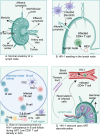Spatial technologies to evaluate the HIV-1 reservoir and its microenvironment in the lymph node
- PMID: 39058091
- PMCID: PMC11324018
- DOI: 10.1128/mbio.01909-24
Spatial technologies to evaluate the HIV-1 reservoir and its microenvironment in the lymph node
Abstract
The presence of the HIV-1 reservoir, a group of immune cells that contain intact, integrated, and replication-competent proviruses, is a major challenge to cure HIV-1. HIV-1 reservoir cells are largely unaffected by the cytopathic effects of viruses, antiviral immune responses, or antiretroviral therapy (ART). The HIV-1 reservoir is seeded early during HIV-1 infection and augmented during active viral replication. CD4+ T cells are the primary target for HIV-1 infection, and recent studies suggest that memory T follicular helper cells within the lymph node, more precisely in the B cell follicle, harbor integrated provirus, which contribute to viral rebound upon ART discontinuation. The B cell follicle, more specifically the germinal center, possesses a unique environment because of its distinct property of being partly immune privileged, potentially allowing HIV-1-infected cells within the lymph nodes to be protected from CD8+ T cells. This modified immune response in the germinal center of the follicle is potentially explained by the exclusion of CD8+ T cells and the presence of T regulatory cells at the junction of the follicle and extrafollicular region. The proviral makeup of HIV-1-infected cells is similar in lymph nodes and blood, suggesting trafficking between these compartments. Little is known about the cell-to-cell interactions, microenvironment of HIV-1-infected cells in the follicle, and trafficking between the lymph node follicle and other body compartments. Applying a spatiotemporal approach that integrates genomics, transcriptomics, and proteomics to investigate the HIV-1 reservoir and its neighboring cells in the lymph node has promising potential for informing HIV-1 cure efforts.
Keywords: HIV-1; HIV-1 reservoir; human immunodeficiency virus; lymph node; spatial technologies; tfh.
Conflict of interest statement
The authors declare no conflict of interest.
Figures

References
-
- UNAIDS . 2023. World AIDS day 2023. UNAIDS. Available from: https://www.unaids.org/sites/default/files/media_asset/UNAIDS_FactSheet_...
-
- Chun TW, Carruth L, Finzi D, Shen X, DiGiuseppe JA, Taylor H, Hermankova M, Chadwick K, Margolick J, Quinn TC, Kuo YH, Brookmeyer R, Zeiger MA, Barditch-Crovo P, Siliciano RF. 1997. Quantification of latent tissue reservoirs and total body viral load in HIV-1 infection. Nature 387:183–188. doi:10.1038/387183a0 - DOI - PubMed
Publication types
MeSH terms
Grants and funding
LinkOut - more resources
Full Text Sources
Medical
Research Materials
